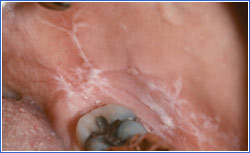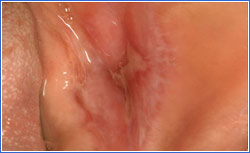Lichen Planus
Oral lichen planus (LP) is a common, chronic inflammatory condition of unknown etiology, which affects 1-2% of adults. Current evidence suggests an immune-mediated mechanism. All age groups may be affected, but adults over 40 years of age predominate with a female-to-male ratio of 1.4:1.
Reticular LP
- Appears as white lacy striations or papules bilaterally on the posterior buccal mucosa.
- Other sites, such as the tongue or gingiva, may be involved.
- It is often readily identified clinically.
General LP Symptoms
- Symptoms tend to wax and wane over years.
- Up to two-thirds of patients complain of some sensitivity, especially with erythematous and erosive forms.
- Up to 44% of patients develop extraoral lesions on the flexor surfaces of the extremities, scalp, and nails.
- Up to 25% of women may have genital involvement. Incidence among men is much lower.
Other forms of Oral LP*
- Plaque-like white lesions
- Erythematous or atrophic
- Erosive
- Bullous
- Lesions may exhibit mixed types often with zones of tender erythema and painful ulcers, surrounded by peripheral white, radiating striae.
- May present with generalized erythema and ulceration of the gingiva known as desquamative gingivitis.
Reticular Lichen Planus

Erosive Lichen Planus

Treatment
- Asymptomatic patients do not require treatment.
- For symptomatic patients, topical corticosteroid gels or mouth rinses are helpful.
- Lesions not exhibiting classic features may require biopsy for diagnosis.
* Note that extra-oral Lichen Planus has a very different appearance described as purple, polygonal, pruritic (itchy), planar (flat-topped), papules, and plaques.
References
Gonsalves WC, Chi AC, Neville BW, Common Oral Lesions: Part I. Superficial Mucosal Lesions, AFP 2007;75:501-507.
Pappas PG, Kauffman CA, Andes D, et al. Clinical Practice Guidelines for the Management Candidiasis: 2009 Update by the Infectious Diseases Society of America. Clinical Infectious Diseases. 48(5): 503-535.